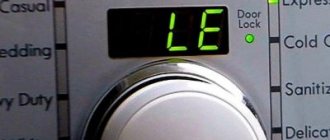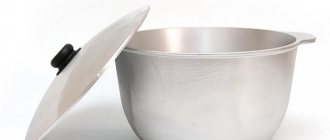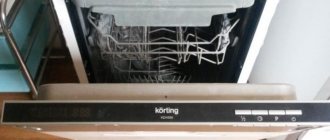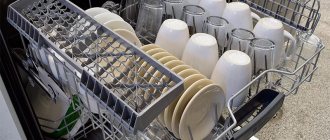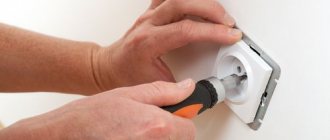How to care for your dishwasher?
To extend the life of a household appliance, you need to learn how to properly care for it. The user must constantly clean the filter elements from accumulated debris, as well as rinse the basket, remove scale and rust.
Every 20 rinsing cycles, the unit is washed with a degreaser or citric acid, and significant deposits are removed manually. Do not leave blockages inside the household appliance; dirt accumulations are removed using a thin wire bent with a hook.
You can remove mold using bleach, but this product is not recommended for use on equipment whose drum is made of stainless steel. A similar treatment is done without adding dishes at low speeds for 10 minutes. Rust on a household appliance is treated with sealant or coated with paint.
A well-maintained car means clean dishes.
Various stains inevitably appear even if the machine itself is not working properly. The following factors may be the cause of the failure:
- Dirt accumulated inside the dishwasher. To get rid of it, just start the washing mode without dishes, using special cleaning products. For the same purpose, you can use regular citric acid.
- Calcified deposits on cutlery often indicate clogged filters. In such cases, they need to be replaced or cleaned.
- If you use the machine strictly according to the instructions, and white deposits still appear, you should pay attention to the operation of the sensor, which determines the level of water hardness. To diagnose this type of malfunction, it is best to call a specialist. A similar problem will arise if the ion exchanger breaks down.
- In some Chinese-assembled units, the compartment lid may not fit well, as a result of which it does not close tightly. In such cases, it is better to replace the compartment itself or adjust its operation. Otherwise, avoiding the appearance of white spots on the dishes will be quite problematic.
- A characteristic coating also appears when the machine is overloaded with cutlery or is placed incorrectly, which significantly complicates the rinsing process.
- Regenerating salt, which is used to soften water, should be poured strictly into the ion exchanger. If the product spills or gets into the machine through a poorly closed lid, a white coating may appear on the dishes.
- In order to avoid corrosion, experts advise adding salt immediately before starting the machine. If this substance gets into the ion exchanger, and you do not plan to load dishes yet, you can start the unit using the shortest program.
- Not only hard, but also very soft water contributes to the formation of characteristic stains. In such cases, it is also necessary to set the optimal quality parameters using the instructions.
- It is necessary to load dishes that have been cleared of food into the machine, because clogged filters make draining the water much more difficult. As a result, the resulting scale can settle on internal parts, preventing the free spray of the water jet. This automatically reduces the quality of dishwashing.
The machine will ideally perform the established functions if during its operation all the necessary substances are used in exact proportions. It is also important to regularly clean the unit itself and monitor the serviceability of its working components.
Preventive actions
What to do if the dishwasher leaves residue on the dishes. It is better to prevent a problem than to fight it. To achieve this, the following preventive actions are taken:
- pour salt or liquid softener into a special container;
- We use high-quality rinse aid in the right dosage;
- choose tablets that dissolve well in water and soften the liquid;
- we install additional filters to increase the efficiency of water purification;
- We correctly select and dose detergents for dishes.
When choosing tablets, we select substances that are designed to work in fast programs. They can be replaced with special solutions and powders. Rinse aid and salt should be placed in separate containers.
White residue on dishes after dishwasher
Your dishwasher has been pleasing you for a long time with its impeccable cleaning quality, when suddenly, after yet another use, you notice that there is a strange white coating, streaks, stains left on the dishes... This is very noticeable on pans with a non-stick (Teflon) coating.
Perhaps you found the same coating on the walls of the dishwasher itself. What is this? Malfunction? Or did you do something wrong yourself? Let's figure it out.
White deposits on dishes and inside the dishwasher - what to do and how to get rid of them
If a whitish residue remains on the dishes after the dishwasher, do not rush to call the service center. In most cases, you can correct the situation on your own. The table contains possible causes and ways to eliminate them yourself.
Malfunctions in which white streaks remain on dishes and internal parts of the dishwasher
The appearance of white spots on dishes and/or walls of the dishwasher after use rarely indicates a technical malfunction of the unit. However, such problems are possible.
*Approximate cost, INCLUDES labor and parts. The exact repair price is determined by the technician after diagnosis and depends on the brand/model of the dishwasher, as well as the complexity of the repair work.
If, after completing the next washing cycle, you find a white coating on the dishes and/or inside the dishwasher, and independent attempts to correct the situation did not lead to the desired result, contact the RemBytTech workshop by phone from 8 a.m. to 10 p.m.:
+7 (495) 215 – 14 – 41
+7 (903) 722 – 17 – 03
or fill out an online application on the website.
Within 24 hours after your call, a qualified technician will come to your home to diagnose and, if necessary, fix the problem. And in a few hours you will forget about the white residue on clean dishes!
The main reasons for the formation of a white coating on dishes after washing in the dishwasher
The same coating can be found on the walls of the device itself. Why does he appear? Over time, deposits, dust, and plaque accumulate on the device. First of all, the device should be cleaned. The filters become clogged with food debris and should be cleaned. Plaque is removed using special means.
Quality and dosage level of detergents
The reasons for the white coating on dishes after washing in the dishwasher vary. One of them is improper distribution of detergent compositions. They may be of poor quality. If there is an excess of them, white spots also remain. Or maybe the amount of rinse aid and conditioner is too small. Sometimes the rinse aid is poured into the wrong compartment. Substances produced in tablet form do not always have time to dissolve. Do not confuse the compartments for detergent compounds.
Wrong detergents selected
Incorrect distribution of detergent compositions can cause white residue. Each brand always has its own detergents. They must be of high quality so as not to damage the car. If they are not selected correctly, then a coating will form on the car in a short time. When washing dishes, some of the scale will fall on it. IMPORTANT: There is no need to purchase capsules; they contain the cheapest and most ineffective products. Why waste money on poor quality products when you can buy excellent products from the following brands:
- Frost Soda;
- Claro;
- Calgonut Finish gel;
- Clean Fresh Active Oxygen Lemon.
Three main reasons for the formation of plaque on dishes
There are only three reasons, but that doesn’t make it any easier. After all, finding the main one at random is not so easy. So here's the list:
- Technical difficulites
- Hardness of water
- Incorrect selection of detergents
It would seem that everything is simple. But, in fact, it’s not easy at all! Each of these reasons has a lot of nuances and it is very difficult for a beginner to understand it all.
Therefore, we advise you to start diagnosing with technical problems first. Of course, if you know for sure that yesterday the dishes were cleaned, and today, after changing the detergent, plaque suddenly appeared, then that’s the problem. Change it and be done with it!
But, if you have a new machine, and the very first wash disappointed you, or if you have an old machine that always washed well, but over time began to leave a residue, then the matter is more complicated.
If you have had your machine for a long time, we recommend that you begin diagnostics in the sequence given in the table of contents.
If it’s completely new, then you need to start with the points: “Poor quality of detergent”, “Incorrect dosage as the cause of the problem”, “Water hardness and how to choose a product”, “Reduced water supply pressure and how to deal with it”.
See also -
How a dishwasher works (basic principles)
Solution
Sometimes specialist intervention is required. In these cases, a service employee is invited to your home. The technician can take the car to the service center for repairs. The housewife will have to do without her faithful assistant in the kitchen for some time. For less serious problems, it is possible to solve the problem yourself. There are several ways to do this.
Sometimes specialist intervention is required.
Methods of dealing with the white problem
There aren't too many of them. But they are all effective and improve the situation. These methods are aimed at solving the problem independently.
Removing white plaque
If white limescale remains on the dishes or walls of the structure, then it is necessary to adjust the degree of water hardness and, before starting the unit, adjust the salt supply to the required value.
How to determine water hardness:
- Use special test strips.
- Seek advice from housing office employees.
To correct the appearance of deposits, you need to adjust the salt supply in the dishwasher by studying the product's instruction manual. To obtain “soft” water, pour regenerating salt into a special device, which will regulate the hardness of the water in the water supply (in the future, monitor its quantity).
An equally common cause of white spots and streaks is poor quality and incorrect dosage of detergent.
Plaque on dishes occurs if:
- The powder didn't wash off well.
- The tablet did not dissolve completely.
- Poor quality of rinse aid (lack of it).
It is important to correctly determine the calculation of rinse aid for one wash - if there is a shortage, a white coating will remain on the dishes, and if there is an excess, there will be excessive shine and a welcoming film. Low quality tablets (3 in 1) are poorly washed out. White streaks may appear due to regenerating salt getting into the washing chamber. In this case, you need to thoroughly clean the loading area from its residues and tighten the compartment lid tightly.
It is forbidden to mix different products for cleaning machine elements, especially using bleach with other chemicals - you can damage the rubber gaskets and cause structural leaks.
Readers' experience: The first thing I do is clean the filter.
It is located at the bottom of the machine and water drains through it.
It consists of:
Flat mesh. Called a fine filter. Intercepts the smallest specks;
External coarse filter. It resembles a glass with a mesh of small cells - located immediately under the mesh.
Internal coarse filter (located inside the glass).
If the filter becomes clogged (mainly due to food debris and fat accumulation on it), then pumping into the circulation system is blocked, after which the machine stops draining water.
Therefore, you need to wash the filter regularly; this is also stated in the instructions for using the dishwasher. This is done very simply - just rinse it under running water and clean it with any brush.
In addition to cleaning the filter, I also run the machine with cleaning agent every three months.
Methods to combat the problem of white residue on dishes
To eliminate the issue of deposits, correctly determine the reason why the dishes in the dishwasher have a white coating.
If the source of sediment is the hardness of the water supply to the machine, follow these steps:
- establish how much the PH is exceeded;
- use test strips;
- select salt and cleansing agents that can soften the liquid. Refusal of medications leads to the formation of a white harmful coating on equipment parts and its breakdown.
Savings on dishwasher preparations are unjustified. Cheap options do not cope with the task assigned to the machine and leave tarnish on the walls of the product. A bad powder does not remove dirt; a low-quality rinse aid allows white spots to pass through. The absence of preventive components leads to breakdown and costly repair of the device.
By following the rules for loading attributes, filling a functioning dishwasher with the specified number of items, you can extend the life of the product and get rid of plaque.
To resolve technical problems, it is recommended to contact specialists. They will clean parts, filters from dirt, white scale, and repair the water hardness sensor.
Advice from experienced owners
During use, customers discovered various ways to improve the quality of washing and cope with stains. It is noted that cheap, low-quality dishes are more difficult to wash in the dishwasher. Sometimes you have to replace some items with more expensive ones or completely change the brand.
If the dishes in the chamber are not placed correctly, the quality of washing may noticeably deteriorate, which contributes to the appearance of a white residue at the end of the cycle
For certain items and depending on the type of dirt, you need to choose the right wash cycle. Also, do not exceed the number of items allowed for loading at one time. The number of sets is indicated in the instructions. Problems can also arise when dishes are placed incorrectly in the chamber.
On forums and review sites you can find a lot of useful tips for specific dishwasher models. It makes sense to carefully study such recommendations in order to learn not from your own mistakes, but from others.
The following article will help you understand the intricacies of the dishwasher, familiarize yourself with the parts of the unit and their maintainability, which we highly recommend reading.
Conclusions and useful video on the topic
Video about the causes of plaque in the dishwasher and the most effective way to eliminate them:
Plaque on dishes is an unpleasant phenomenon, but quite common. It’s not difficult to get rid of it; you need to soften the water and clean the equipment in a timely manner. If the machine is operated correctly, the likelihood of problems occurring will be minimal.
Want to talk about a simpler and easier way to get rid of the white mineral deposits that form in your dishwasher? Do you have an effective technique that is worth sharing with site visitors? Please write comments in the block below, ask questions and publish photographs on the topic of the article.
